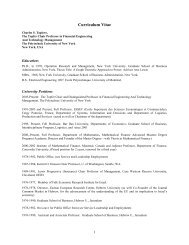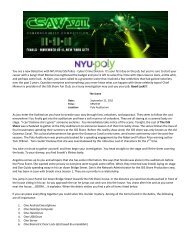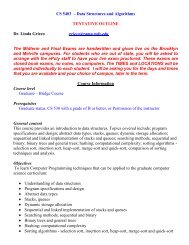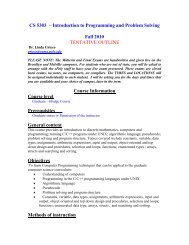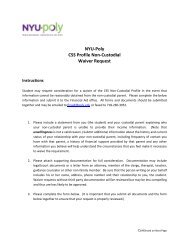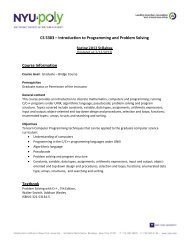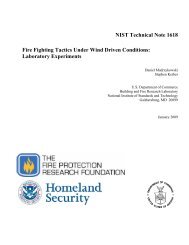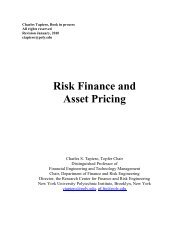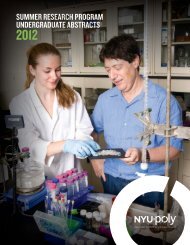Cable 2005 fall v1 - Polytechnic University
Cable 2005 fall v1 - Polytechnic University
Cable 2005 fall v1 - Polytechnic University
Create successful ePaper yourself
Turn your PDF publications into a flip-book with our unique Google optimized e-Paper software.
PolyNews<br />
Poly Professor Collaborates on Post-Hurricane<br />
Water Decontamination Research<br />
The devastation wreaked by Hurricane<br />
Katrina on New Orleans posed massive<br />
public health problems not the least of<br />
which was treating contaminated flood water<br />
before it came in contact with humans or was<br />
pumped into natural reservoirs. National Science<br />
Foundation-funded researchers, including<br />
José Pinto, an associate professor of chemical<br />
and biological engineering at Poly, have developed<br />
a novel system that uses a simple water<br />
purification technique that can eliminate 100<br />
percent of the microbes in New Orleans water<br />
samples left from Hurricane Katrina. The technique<br />
makes use of specialized resins, copper<br />
and hydrogen peroxide to purify tainted water.<br />
The system, safer, cheaper and simpler to use<br />
than many other methods, breaks down a range<br />
of toxic chemicals. While the method cleans the<br />
water, it does not yet make the water drinkable.<br />
However, the new system may eventually prove<br />
critical in limiting the spread of disease at disaster<br />
sites around the world. “After the disaster of<br />
Hurricane Katrina,” Pinto points out, “a need<br />
emerged for simple water decontamination treatment<br />
processes that could be operated by nontechnical<br />
personnel, are cost effective and do not<br />
generate toxic by-products.”<br />
The treatment system that Pinto and the<br />
researchers are developing is simple: a polymer<br />
sheet of resins containing copper is immersed in<br />
contaminated flood water. The addition of<br />
hydrogen peroxide<br />
generates free radicals<br />
on the polymer.<br />
The free radicals<br />
remain bound to the<br />
sheet where they<br />
come in contact with<br />
bacteria and kill<br />
them. To develop<br />
their process, the<br />
researchers built<br />
upon a century-old<br />
chemical process<br />
called the Fenton<br />
reaction—a process<br />
wherein metal catalysts<br />
cause hydrogen peroxide to produce large<br />
number of free radicals.<br />
Pinto explains that free radicals are atoms or<br />
molecules that have an extra electron in dire<br />
need of a partner; they obtain the partner by<br />
stripping it from a nearby atom, damaging the<br />
“victim” in the process. In large quantities, the<br />
radicals can destroy toxic chemicals and even<br />
bombard bacteria to death or irreparably damage<br />
a microorganism’s cell membrane.<br />
Researchers Vishal Shah and Shreya Shah of<br />
Dowling College in Long Island, New York, and<br />
Boris Dzikovski of Cornell <strong>University</strong> collaborated<br />
with Pinto. They will publish their findings<br />
in the journal Environmental Pollution.<br />
Professor José Pinto and Bahati<br />
Dramou ’07 CBE, are developing<br />
a mathematical model to predict<br />
the optimal amounts of polymer,<br />
copper and hydrogen peroxide for<br />
effective water decontamination.<br />
Plesniak, Fluid Dynamics Expert, Named to Kleiner Chair<br />
Michael Plesniak<br />
Michael Plesniak, renowned for his work in<br />
fluid dynamics, has been named the first<br />
professor to hold the Eugene Kleiner<br />
Chair for Innovation in the Department of<br />
Mechanical, Aerospace and Manufacturing Engineering.<br />
As a member of the engineering faculty<br />
at Purdue <strong>University</strong>, Plesniak applied his work in<br />
fluid dynamic principles to functions of the human<br />
body focusing on the cardiovascular system and<br />
human speech production. His outstanding<br />
research led to his appointment as the program<br />
director for the National Science Foundation. He<br />
holds a doctorate in mechanical engineering from<br />
Stanford <strong>University</strong> and bachelor’s and master’s<br />
degrees from the Illinois Institute of Technology.<br />
cable winter 2007 9




